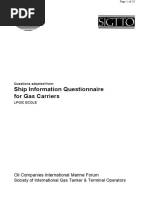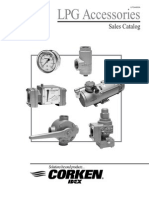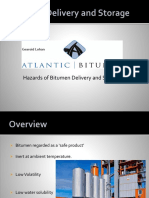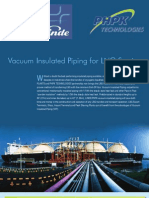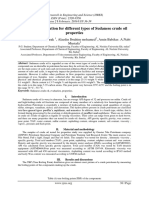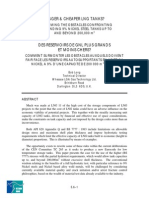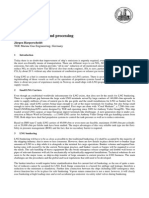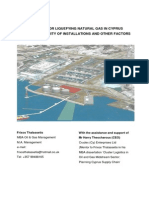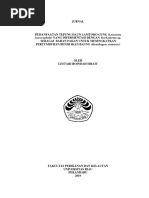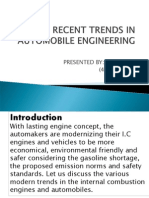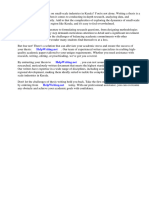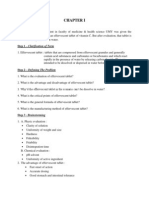Offshore Terminals For The Transportation of Liquefied Petroleum Gas
Offshore Terminals For The Transportation of Liquefied Petroleum Gas
Uploaded by
Pavithra AnandanCopyright:
Available Formats
Offshore Terminals For The Transportation of Liquefied Petroleum Gas
Offshore Terminals For The Transportation of Liquefied Petroleum Gas
Uploaded by
Pavithra AnandanOriginal Title
Copyright
Available Formats
Share this document
Did you find this document useful?
Is this content inappropriate?
Copyright:
Available Formats
Offshore Terminals For The Transportation of Liquefied Petroleum Gas
Offshore Terminals For The Transportation of Liquefied Petroleum Gas
Uploaded by
Pavithra AnandanCopyright:
Available Formats
MOORING AND BERTHING
Offshore terminals for the transportation of Liquefied Petroleum Gas
Ren Raaijmakers, Business Development Manager, Bluewater Offshore Production Systems (USA) Inc., Texas, USA
Demand for Liquefied Petroleum Gas (LPG) is rising, particularly in the residential and commercial sectors of developing and more developed countries. The use of cleaner liquid and gaseous fuels is expected to continue to increase as populations grow and total demand for energy in these regions rises proportionally. At the same time, oil and gas prices have risen to historic levels improving the economics of liquefied gas resulting in stronger transportation demands for LPG. With a number of LPG transportation projects already in the planning stage, many more are expected in the coming years. As access to LPG increases and markets open up, offshore terminals will increasingly play an important role in the overall safety and efficiency of these projects. refrigeration, Bluewater is anticipating the emergent requirement for low temperature transfer technology up to cryogenic conditions, and has adapted standard SPM technology to accommodate this growing market for the safe and efficient mooring and (off)loading of product tankers via an offshore terminal facility.
LPG storage and marine transportation
In the marine transportation market, LPG is typically transported by dedicated vessels suitable for carrying pressurised, semipressurised or refrigerated LPG. The pressurised (18-bar, ambient temperatures) or semipressurised (5-8 bar, -10 to -20 degrees Celsius) LPG ships carry 3 10,000 m3 or 10 30,000 m3 respectively. Larger volumes require refrigerated transport solutions (ambient pressure, but at temperatures as low as -43 degrees Celsius for 100% propane). Fully refrigerated vessels typically have cargo volumes ranging from 35,000 m3 up to 100,000 m3. Evaluating the markets for LPG transportation world-wide, a trend is developing towards the refrigerated transport of LPG in large volumes. The offshore terminal solution is suitable for all three types of transfer. The loading/un-loading cycle, including the mooring and departure procedures, can usually be achieved in about a day. The offshore terminal consists of a mooring and fluid transfer system (SPM), connected by means of a subsea pipeline to the LPG storage facility onshore. The SPM mooring system enables the vessel to freely weathervane in response to the wind, wave and current conditions. The pipeline (single or dual) may be
Overview
LPG consists of butane and propane and may contain minor quantities of other light hydrocarbons associated with the production of oil and gas. At ambient temperature and pressure these components exist as a gas but can be cooled and/or pressurised to facilitate efficient liquid storage and transportation. Loading the LPG directly into or out of a tanker offshore is essential for many projects in order to capitalise on the market demand. Over the past four decades Single Point Mooring (SPM) technology applications have become a preferred method of cargo transfer from tankers to shore and vice versa. SPM technology has proven its reliability and cost effectiveness. In particular, near isolated coastlines, in areas where natural harbours are scarce or where the costs of constructing harbours and jetty structures are prohibitive. Since transportation of large volumes of LPG requires
Single Point Mooring (SPM).
P O RT T E C H N O L O G Y I N T E R N AT I O N A L
99
MOORING AND BERTHING
LPG buoy.
several kilometres long, depending on local bathymetry, vessel characteristics and the operating philosophy of the onshore terminal. Transfer of propane and/or butane at refrigerated or semi-pressurised conditions through the fluid transfer system may require the use of insulated pipelines to prevent the LPG from warming due to the environment The insulation ensures that the products are kept at the temperature agreed upon between the terminal operator and the shipping company.
Advantages of SPM based offshore terminals
SPM terminals offer a practical solution with a number of advantages. Congested harbours can be relieved and the difficulties and expense of upgrading quaysides and jetties can be overcome, particularly where any combination of larger vessels, limited water depth and rapidly changing weather conditions are prevalent. The SPM based terminal also allows very high availability and workability through its capacity to adapt to the environmental conditions.
Key Advantages of offshore terminals incorporating an SPM: No need for port/harbour infrastructure Products will be imported or exported via a pipeline without the need for any quays. This provides tremendous flexibility to the project team when selecting the optimum location with respect to licence for the tank facilities, the in-land infrastructure and markets. No need for dredging The terminals are located in deeper and open waters, thus no depth maintenance by dredging is required. Less need for tugs and no port-pilots or harbour operations The open waters are far less congested than inshore waterways, correspondingly increasing the manoeuvrability and safety of marine operations. Easy and quick implementation of terminal Offshore Terminals can be built quickly and can be operational in less than one year after project sanction. No tanker size restrictions SPM systems can be designed for any tanker size. Tankers are moored at the bow only, which makes the system virtually insensitive to length and width of the vessel. The SPM is, therefore, the best suited design to include in most offshore terminals. All-weather functionality and rapid turnaround A key feature of an SPM system is its weathervaning capability. The buoy is able to weathervane freely through 360. This allows the tanker to approach the system from any direction. Therefore, depending on the environmental conditions at any given time, the most favourable direction is chosen for tanker approach. Once moored, the vessel will find a neutral position that results in the lowest environmental loads and safest vessel sea-keeping. Minimum manning requirement Since berthing can take place from any direction and only a single mooring point at the bow has to be established, the manning requirement is reduced to assistance of passing over the mooring hawser and the floating hoses to the vessel. Minimal inspection and maintenance requirements.
Multi-product transfer terminal
A 4-buoy Conventional Buoy Mooring (CBM) system was recently deployed close to the shoreline of Madeira, Portugal.
A 4-buoy CBM system was recently deployed close to the shoreline of Madeira, Portugal.
100 P O RT T E C H N O L O G Y I N T E R N AT I O N A L
www.p o r t t e c h n o l o g y. o r g
MOORING AND BERTHING
Close up of a 4-buoy CBM system.
LPG buoy in operation.
This terminal provides the main import facility for LPG, black and white products (gasoline, diesel, fuel oil and kerosene) for the energy and power consumption for the island. Transfer of the products from the tankers is made through flexible hoses, designed to adapt to the motions of the vessel and connecting the vessel to the Pipeline End Manifold (PLEM) placed on the seabed. Each PLEM connected pipeline (three in total) connects to a different shore reservoir, depending on the offloaded product. While the environmental safety of the offloading process is always the prime objective when developing an offshore terminal for the transfer of oil products, Madeiras economic success was particularly dependent on developing a storage and offloading terminal that could sustain its energy needs as well as its tourism. Madeiras new CBM system satisfies both requirements and has helped enable Madeira to maintain a stable supply of affordable energy, minimising the islands dependency on the mainland.
ABOUT THE AUTHOR
Ren Raaijmakers holds a Master of Science degree in civil engineering from Delft University of Technology. He joined Bluewater in 1996 as a concept development and design engineer responsible for performing design, analyses and model testing on SPM buoys and mooring and riser systems for floating production facilities. He later became tender manager and is currently business development manager for South, Central and Latin America and the Caribbean, whilst based in Houston, Texas.
The future of LPG terminals
Bluewater has successfully installed several offshore LPG terminals based on CBM systems. A CBM is a non-weathervaning tanker mooring system, applicable to very benign locations and accommodating relatively small vessels. However, the design and operational philosophies applicable to those terminals have also been fully applied to the design and practical implementation of the fully weathervaning SPM type offshore terminal. The complete implementation of an LPG offshore terminal as a turnkey project from start to the first loading/off-loading operation can be completed in less than one year. With the forecasted increase in liquefied gas projects over the next five years, LPG SPMs are expected to provide an economical and safe alternative to traditional methods of LPG transportation.
ABOUT THE COMPANY
Since 1978, Bluewater has been a leader in the design of mooring and transfer systems for the safe and efficient conveyance of fluids. With a global portfolio built upon flexibility, versatility and customer-client collaboration, Bluewater is today responsible for some of the most innovative offshore terminal systems in service throughout the world. Bluewater also owns and operates a fleet of floating oil and gas production systems, leased to clients world-wide.
ENQUIRIES
Bluewater Offshore Production Systems (USA), Inc. 8554 Katy Freeway, Suite 327 Houston Texas 77024 USA Tel: +1 713 722 8131 Fax: +1 713 722 8145 E-mail: rraaijmakers@bluewater-offshore.com
Bluewater Energy Services B.V. (Corporate Headquarters) Marsstraat 33 Hoofddorp 2132 HR The Netherlands Tel: +31 (23) 568 2828 Fax: +31 (23) 565 2053 E-mail: info@bluewater.com Web site: www.bluewater.com
P O RT T E C H N O L O G Y I N T E R N AT I O N A L
101
You might also like
- LPG Reticulation Systems For Householdoctober 2023Document42 pagesLPG Reticulation Systems For Householdoctober 2023Iddi OmarNo ratings yet
- KG002202 - EnglishDocument72 pagesKG002202 - EnglishE-enk Maturbongs100% (1)
- Intertanko Gas and Marine Seminar: Blending/Commingling of LPG Cargoes On Board Gas CarriersDocument19 pagesIntertanko Gas and Marine Seminar: Blending/Commingling of LPG Cargoes On Board Gas Carriersmouloud miloud100% (1)
- Loading LPG CalculationsDocument12 pagesLoading LPG CalculationsJohn Green80% (5)
- IELE LNG Safety and Security1Document81 pagesIELE LNG Safety and Security1Denstar Ricardo SilalahiNo ratings yet
- Design of LPG Terminal PDFDocument1 pageDesign of LPG Terminal PDFLPG TERMINAL0% (1)
- Docking & Mooring For LNGDocument20 pagesDocking & Mooring For LNGBobby100% (1)
- Rubis Terminal GBDocument21 pagesRubis Terminal GBsizwehNo ratings yet
- Safety Practices in The LPG Gas IndustryDocument64 pagesSafety Practices in The LPG Gas IndustryChristian Vargas100% (1)
- Inspection OF Loading and Unloading Hoses FOR Petroleum ProductsDocument25 pagesInspection OF Loading and Unloading Hoses FOR Petroleum ProductsSuraj SarojNo ratings yet
- Tanker Terminal and Liquid Cargo CourseDocument4 pagesTanker Terminal and Liquid Cargo CourseAnonymous yJ7VjL28iNo ratings yet
- LNG - Fueling The FutureDocument17 pagesLNG - Fueling The FutureJulia OscanoaNo ratings yet
- 212022사우디아라비아진출전략Document57 pages212022사우디아라비아진출전략Peter ShimNo ratings yet
- Gas (LPG) : SwedenDocument12 pagesGas (LPG) : SwedenAntony MylvaganamNo ratings yet
- 8 4 Carlo MangiaDocument21 pages8 4 Carlo MangiayuniNo ratings yet
- LPG 11ahmadDocument36 pagesLPG 11ahmadJackk Sparooww100% (1)
- OLPG S1-01 - OESA LPG Depots and Filling PlantsDocument38 pagesOLPG S1-01 - OESA LPG Depots and Filling PlantsGogne Rodolph100% (1)
- 20170406-FINAL+LNG+EHS+Guideline April+2017Document24 pages20170406-FINAL+LNG+EHS+Guideline April+2017alyshahNo ratings yet
- Installation of LPG Storage VesselDocument6 pagesInstallation of LPG Storage VesselangellaNo ratings yet
- Guidelines For: Good Safety Practices in The LP Gas IndustryDocument64 pagesGuidelines For: Good Safety Practices in The LP Gas IndustryLuis Alberto SanchezNo ratings yet
- The Petroleum (Refining Conversion Transmission and Midstream Storage) Act 2013Document80 pagesThe Petroleum (Refining Conversion Transmission and Midstream Storage) Act 2013African Centre for Media ExcellenceNo ratings yet
- LPG PipingDocument20 pagesLPG PipingLelosPinelos123100% (4)
- 205 PV LPGDocument211 pages205 PV LPGf166No ratings yet
- Pump Selection For The LNG IndustryDocument0 pagesPump Selection For The LNG IndustryZaid Tariq AlabiryNo ratings yet
- Arrow LNG - Project Description PDFDocument58 pagesArrow LNG - Project Description PDFRoozbeh PNo ratings yet
- Specification For Auto LPG Dispensing StationDocument5 pagesSpecification For Auto LPG Dispensing StationShyBokxNo ratings yet
- Ecole Sigtto QuestionareDocument18 pagesEcole Sigtto QuestionareImmorthalNo ratings yet
- LPG AccesoriesDocument24 pagesLPG Accesoriessizweh100% (1)
- LPG Process FlowDocument12 pagesLPG Process FlowGodfrey Jr Jr.No ratings yet
- Bitumen UnloadingDocument13 pagesBitumen Unloadinghasriyani100% (1)
- Emsa Final Report Bunkering LNG Op 06 2012 BDocument160 pagesEmsa Final Report Bunkering LNG Op 06 2012 BEric Berger100% (2)
- 9-10-2014 CWMA CNG-LNG Presentation 2014 (246 Pages)Document246 pages9-10-2014 CWMA CNG-LNG Presentation 2014 (246 Pages)kkaranagNo ratings yet
- Minimize Evaporation Losses by Calculating Boiloff Gas in LPG Storage TanksDocument6 pagesMinimize Evaporation Losses by Calculating Boiloff Gas in LPG Storage Tanksaegean227100% (1)
- Engro Fast Track LNG Regasification ProjectDocument175 pagesEngro Fast Track LNG Regasification ProjecttoufeeqahmedsathioNo ratings yet
- Review of LPG Market in 20 Countries 2011Document196 pagesReview of LPG Market in 20 Countries 2011ybbvvprasada rao100% (1)
- Linde LNG PipelineDocument4 pagesLinde LNG PipelineSatis MadhavanNo ratings yet
- Sener Fsru EnglishDocument33 pagesSener Fsru EnglishFrancisco J RodríguezNo ratings yet
- LNG Tank FabricationDocument1 pageLNG Tank FabricationtndeshmukhNo ratings yet
- Flash Point - FuelsDocument4 pagesFlash Point - FuelsKadiri OlanrewajuNo ratings yet
- BOG Rate CalculationDocument1 pageBOG Rate CalculationNgoVietCuongNo ratings yet
- Oil Transfer GuidelinesDocument34 pagesOil Transfer GuidelinesToufik BensariNo ratings yet
- Natural Gas Production, Transportation - StorageDocument36 pagesNatural Gas Production, Transportation - StorageNeeraj YadavNo ratings yet
- Study and Evaluation For Different Types of Sudanese Crude Oil PropertiesDocument4 pagesStudy and Evaluation For Different Types of Sudanese Crude Oil PropertiesInternational Journal of Research in Engineering and ScienceNo ratings yet
- Bigger and Cheaper LNG TanksDocument28 pagesBigger and Cheaper LNG Tanksbalavengu100% (1)
- Blackmer LPG Handbook 500Document38 pagesBlackmer LPG Handbook 500Eduardo Paulini VillanuevaNo ratings yet
- Cryotec Small Scale LNG EngDocument5 pagesCryotec Small Scale LNG EngRamesh Nair100% (1)
- Final CrudeOil and Petroleum Product TerminalsDocument14 pagesFinal CrudeOil and Petroleum Product Terminalsbalavengu100% (1)
- ABS - Gas Fueled Ships Guide 2014Document100 pagesABS - Gas Fueled Ships Guide 2014aleksandar_djordjic100% (1)
- 5000m3 LPG Tank FarmDocument2 pages5000m3 LPG Tank FarmLpgTankFarm50% (2)
- Operational Sparing PhilosophyDocument2 pagesOperational Sparing PhilosophyAsho AshourNo ratings yet
- Nitrogen DataDocument8 pagesNitrogen DatanitrovertNo ratings yet
- Ship To Shore Transfer of LNG - A New ApproachDocument13 pagesShip To Shore Transfer of LNG - A New ApproachalyshahNo ratings yet
- PT26 - LPG SPM - BluewaterDocument3 pagesPT26 - LPG SPM - BluewaterKrishna HartonoNo ratings yet
- Buoyed Up: Proven in The Past, Prepared For The FutureDocument10 pagesBuoyed Up: Proven in The Past, Prepared For The FutureantidemosNo ratings yet
- Spe-170600-Ms Floating LNG Chain - Finally A Reality: Michael S. Choi, ConocophillipsDocument11 pagesSpe-170600-Ms Floating LNG Chain - Finally A Reality: Michael S. Choi, Conocophillipsthlim19078656No ratings yet
- LNG As Fuel - Bunkering, Storage and Processing: Jürgen HarperscheidtDocument2 pagesLNG As Fuel - Bunkering, Storage and Processing: Jürgen HarperscheidtB6D4N0No ratings yet
- CALM Buoy Brochure EnglishDocument4 pagesCALM Buoy Brochure EnglishnyghodsiNo ratings yet
- Design and Construction of LNG RegasificDocument12 pagesDesign and Construction of LNG RegasificOusseini SidibeNo ratings yet
- Offshore LNG Loading Problem SolvedDocument13 pagesOffshore LNG Loading Problem SolvedpriyoNo ratings yet
- Cyprus LNG Terminal EngDocument12 pagesCyprus LNG Terminal Engapi-252576407100% (1)
- 1 SMDocument17 pages1 SMmuhammad20381No ratings yet
- Innovative CSR!!!Document24 pagesInnovative CSR!!!XIther1935No ratings yet
- Presented By: Rajesh M S (4mc04au013)Document18 pagesPresented By: Rajesh M S (4mc04au013)Vinod SubramaniamNo ratings yet
- Beckwith's Stages of Spiritual GrowthDocument25 pagesBeckwith's Stages of Spiritual GrowthJoanne Mae Montano100% (1)
- Greaves Cotton LTDDocument3 pagesGreaves Cotton LTDKiran GollaNo ratings yet
- Ministry of Defence Defence Standard 80-217Document12 pagesMinistry of Defence Defence Standard 80-217LjubomirSinđelićNo ratings yet
- Guidelines On Construction Activities at Night Reviewed 2Document63 pagesGuidelines On Construction Activities at Night Reviewed 2sanizan80100% (1)
- Practice 1 - Chapter 2Document2 pagesPractice 1 - Chapter 2Nguyễn ĐứcNo ratings yet
- William ShatnerDocument1 pageWilliam ShatnerJames JacksonNo ratings yet
- The Last Lie Told (Debra Webb)Document259 pagesThe Last Lie Told (Debra Webb)Fikir HailegiorgisNo ratings yet
- Mgu Thesis Based On Small Scale Industries in KeralaDocument7 pagesMgu Thesis Based On Small Scale Industries in Keraladwsjyt34100% (2)
- HPK03Document4 pagesHPK03Tan CkNo ratings yet
- CHAPTER ONE_241121_231707Document21 pagesCHAPTER ONE_241121_231707Rachmani Sarah DewayantiNo ratings yet
- Oled LCD Led TV Repair (136-181)Document46 pagesOled LCD Led TV Repair (136-181)darmNo ratings yet
- ANSC 171 Final NotesDocument3 pagesANSC 171 Final NotesLyn RamadaNo ratings yet
- Smith, Anne - Phoenician Ships PDFDocument204 pagesSmith, Anne - Phoenician Ships PDFgarlik666No ratings yet
- Task Card Electrical LRU 002Document4 pagesTask Card Electrical LRU 002Rafael BorbaNo ratings yet
- Xxpol 1710 2690Mhz 65° 18dbi Adjustable Electrical Downtilt Antenna, Manual or by Optional Rcu (Remote Control Unit)Document1 pageXxpol 1710 2690Mhz 65° 18dbi Adjustable Electrical Downtilt Antenna, Manual or by Optional Rcu (Remote Control Unit)Merab KvitsaridzeNo ratings yet
- Ashtang Mantra For Prosperity Meditation Kundalini YogaDocument2 pagesAshtang Mantra For Prosperity Meditation Kundalini Yogatimsmith1081574100% (1)
- 15282Document98 pages15282Oluwatosin Peter AtandaNo ratings yet
- ADuaADay JustDuas UpdatedDocument38 pagesADuaADay JustDuas UpdatedamaniNo ratings yet
- IPMSM 2Document25 pagesIPMSM 2xakira320No ratings yet
- Manual Conair 1875 (Español - 2 Páginas)Document2 pagesManual Conair 1875 (Español - 2 Páginas)Sofía LopezNo ratings yet
- Proof of Kepler's Laws From First Principles: 1 PrerequisitesDocument6 pagesProof of Kepler's Laws From First Principles: 1 PrerequisitesTheBayesianJediNo ratings yet
- Merritt Morning Market-Nov9-#2231Document2 pagesMerritt Morning Market-Nov9-#2231Kim LeclairNo ratings yet
- Psychopathology - Introduction - Signs and SymptomsDocument166 pagesPsychopathology - Introduction - Signs and SymptomsSamatha Seetharam0% (1)
- Chapter 1Document18 pagesChapter 1Enis RachmawatiNo ratings yet
- AWS Welding Journal January 2014Document139 pagesAWS Welding Journal January 2014ferrero68No ratings yet


























